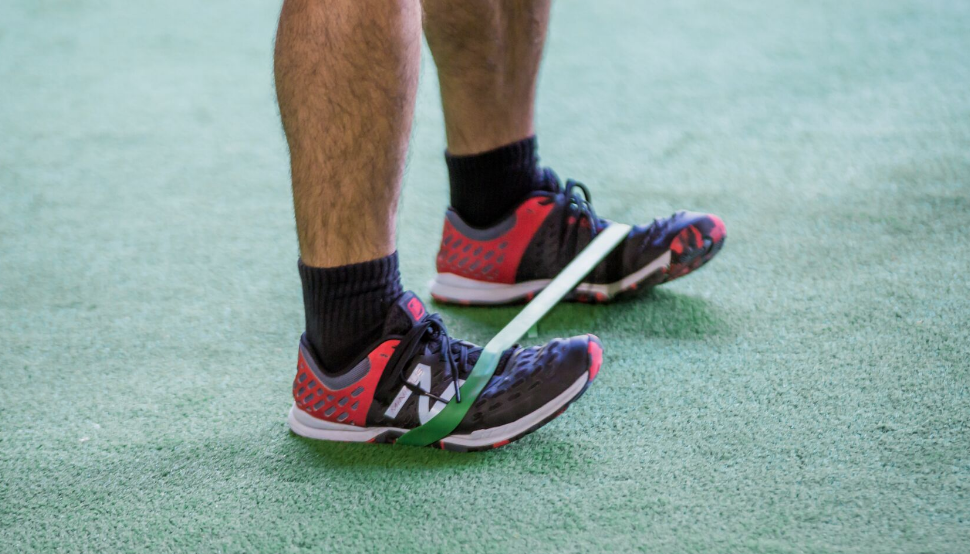The Use of Resistive Bands for Hip Mobility Warm-ups
By: Andy Ford BS CSCS

In getting my athletes ready for a sports speed workout, I have found that prepping their hips with various movements and exercises with a lateral resistor band is a fast and very effective way to accomplish this issue.
How and why I came to this conclusion for this particular type of warm-up prep was simply because:
- Some of my athletes were getting bored with the same dynamic flexibility movement routine (you know knee to chest walks, kicks to opposite hand etc..) and thus were rushing through them.
- Primarily, I wanted an alternative warm-up that was shorter in duration but very effective.
The lateral resistor band, I found, was more effective than the mini bands for quadruped and movement based hip mobility exercises. The mini bands, although very good, have a tendency to “ride up” the legs of the athlete and making it more of a nuisance than anything. Also, it does not provide the elasticity as the lateral resistor band for the exercises.
Although I have tinkered with a different array of positions, ie.. standing with one arm supported against wall, half kneel and high kneel, for the sake of this article I will just go over the quadruped position exercises and some movement exercises. Frankly, in my opinion, they are the most effective positions for loosening up the hips.
Quadruped (all fours position)
- Fire hydrants- Bent hip abducting movement (think dog urinating) preferably lift knee as high as hip.
- Bent hip circles- Perform this movement forward and backward. Try to keep hip high and make big circles.
- Straight hip circles- Leg out side and circle forward and backward. Band should stretch out to that range.
- Straight leg kickbacks- Perform hip flexion movement towards chest and then kick hip back straight.
With all of these, most athletes should be able to do between 10-12 reps. Some weaker and/or tighter athletes begin at 5 or try a lighter resistance band. Make sure hips do the work and not the lower back.
For the movement based portion, I usually begin with walking movements first and then progress to a marching type sequence to a skipping sequence to lastly a sprint mechanic based sequence. Bear in mind not to overdue the routines with a lot of exercises. You have to be careful not to fatigue the working muscles for your athletes sprint work. That, unfortunately, would defeat the purpose.
Examples for walking hip mobility exercises:
- Hip Flexor walk. Step forward as far as possible with right leg. Keep trunk up tall. Do 10yds. Repeat left leg back
- Bent Hip Forward Circle walk- Keep trunk up. Lift hip high and internally rotate hip forward. Do 10yds and then do:
- Bent Hip Backward Circle – I like doing them walking backward and circling hip backward.
- Straight Hip Forward Circle– Same as bent hip circle but try to keep leg straight. Same distance.
- Straight Hip Backward Circle– Perform backwards and reverse hip direction.
- Backwards Hamstring Walk– Start in a staggered stance with hips low. (think defensive back in football) With back leg bent, “punch it” straight as you step backward. Do 10yds and repeat with other leg.
Marching exercises:
- Forward marching with arm mechanics. Keep trunk up. x10yds
- Side Marching x5 or 10yds
- Backward Marching x 10yds
Skipping exercises:
- Forward high hip skips with arm mechanics. Lift hips up towards armpits x 10yds
- Side skipping x 5 or 10yds
- Backward skipping x 10yds
- Bent Hip Circles with skip forward and then backward x 10yds
- Straight Hip Circles with skip same as above.
For the running based exercise, an example is to have the athlete(s) perform an A-run x10yds x1-2 sets.
There are more exercises that I incorporate for each of the progressions. However, personally I prefer more with the walking (6 or so) and then taper down with each progression. After the band routine, my athletes will do ankle mobility exercises lying on their back with both hands under one knee. They will perform clockwise and counterclockwise circles as well as ankle pumps. The key is not to let the knee do the movement; just the ankle. We usually start at 20 circles and pumps and eventually progress to 30 and maybe more.
If necessary, we may add a few traditional dynamic flexibility exercises for their hamstrings, hip flexors, quads and calf musculature.
Without rushing, this type of warm-up will take about 15 minutes. My athletes find this really prepares them well for their sprint mechanic work. They feel and look more fluid during their sprint acceleration work.
If performed on a consistent basis, I have noticed better range of motion and less fatigue in all of the hip movement exercises with the band. Strengthening of the small hip stabilizer muscles as well isolating the bigger gluteals to fire more often are also of benefit. Other feedback I have received from athletes is improved flexibility and better game performance.
——————————————–
About The Author:
Andy Ford is CSCS certified and has a BS degree in Exercise Physiology/Sports Medicine from UMASS-BOSTON He has over 15 years of experience working in the field of strength and conditioning and post rehab. He currently works as an independent contractor at Train Boston Sports Center in Wellesley and Sport-Rx Sports Performance Systems in Pembroke where he is employed as a Sports Performance Specialist or Strength and Conditioning Specialist. He has worked with athletes and teams at all levels. You can reach him at his website www.power-and-speed-training.com


0 Comments for “The Use of Resistive Bands for Hip Mobility Warm-ups”